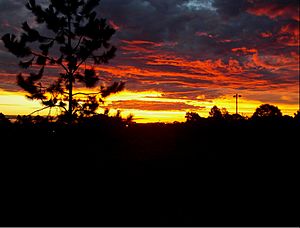Campo Grande, Misiones facts for kids
Quick facts for kids
Campo Grande (Misiones)
|
|
|---|---|
|
Municipality and village
|
|
 |
|
| Country | |
| Province | Misiones Province |
| Time zone | UTC−3 (ART) |
Campo Grande (Misiones) is a town in Argentina. It is located in the Misiones region. This town is the main center of the Cainguás area.
Campo Grande shares its borders with several other towns. These include Aristóbulo del Valle and Ruiz de Montoya. It also borders Jardín América, Campo Viera, Campo Ramón, and towns in the 25 de Mayo department.
Inside the Campo Grande area, you can also find the town of Primero de Mayo. Another important spot is Kilometer 17. Campo Grande is famous for its big celebrations on Teacher's Day. Because of this, it is known as the "Provincial Capital of the Teacher."
Contents
How Many People Live Here?
In 2001, about 5,293 people lived in Campo Grande. This was a big jump from 1991. Back then, only 3,923 people lived there. This means the population grew by almost 35% in ten years!
What Does the Name Mean?
Campo Grande means "Big Field" in Spanish. This name was chosen because the area had a large open field. This was quite unusual for Misiones. Most of Misiones was covered in thick tropical forest.
People believe that the Jesuits might have created this field long ago. Today, you can find many different kinds of medicinal plants and flowers there. Some of these plants are not naturally found in this region.
A Look at History
The First Settlers Arrive
The first settler family came to Campo Grande in 1927. Before that, no settlers lived here permanently. Sometimes, Brazilian people who were hiding would live by hunting and fishing. A Guarani tribe also visited the area now and then.
The very first settler was Carlos Albano Bellot. People called him "Don Carlos, the French." He arrived in 1926. He settled in a place that would later be called "Paraje el Tigre." In 1927, his family joined him.
Finding the Big Field
There were no proper roads back then. Carlos lived in Brazil and came to Oberá in 1926. He was looking for land for his family. There was a small trail, or "picada," that went to Campo Viera. Trucks could use this part.
After Campo Viera, an old logging road continued deeper into the province. But the jungle had grown over it. No one had used it for a long time. Carlos decided to explore this old path. He cut his way through the jungle. Finally, he came out into a large, open field. This was the "Campo Grande."
Starting a New Life
Carlos wanted to find good land to plant yerba mate. He found perfect land near the big field. He cleared the land and planted food like corn, sweet potatoes, and pumpkins. Then, he went back to Brazil to get his family.
The Bellot family had to clear their own path through the jungle. They went from Campo Viera to Campo Grande. They made the path wider in some places. They also built temporary bridges and worked on hills.
Shopping was a big challenge. The Bellot family had to travel all the way to Villa Svea, in Oberá. That was where the closest store was.
More Families Join In
Carlos told others about the good land he found. He said it was perfect for planting yerba mate. In 1928, the second settler family arrived. This was the family of Don David Vichy. His foreman, Mr. Feliciano Montenegro, came with him. The Michelón family also arrived around the same time. In 1929, the Sartori brothers, Guillermo and Pedro, came to Campo Grande.
Early Buildings and Roads
Around 1929 or 1930, the police set up a station. They used an old, empty shack. This shack was next to a spring. It was also on the edge of the Jesuit field. Years later, an airfield would be built there.
Later, a man from Paraguay built another shack. It was right in front of the police station. When the gendarmerie (a type of military police) moved in next to the police, this man sold his shack to Don Vázques.
The small trail, or "picada," became "Route 14" around 1930. At that time, this road went through an area now called "La Novena" in Campo Grande.
Growing Yerba Mate
Don Michelón planted yerba mate for a man named Gamberini. Mr. Gamberini was from Rosario. Over time, Mr. Gamberini also came to live in the area. He was the grandfather of a man known as "Pucho" Lanciani.
Don Carlos el Francés and his family planted a huge amount of yerba mate. They planted about 400 hectares (that's like 1,000 acres!). Later, he gave away some of his land. This land was used to build School Number 209, the Church, and the Cemetery of Paraje el Tigre. He also helped to set up the first Civil Registry in Campo Grande.
See also
 In Spanish: Campo Grande (Misiones) para niños
In Spanish: Campo Grande (Misiones) para niños

